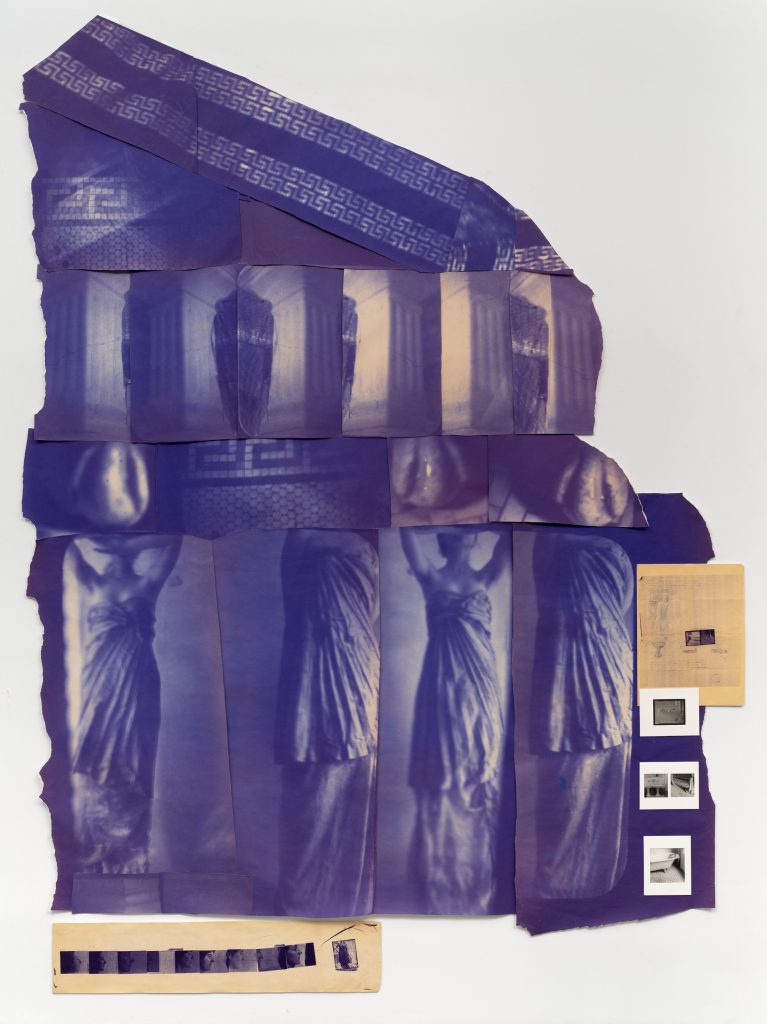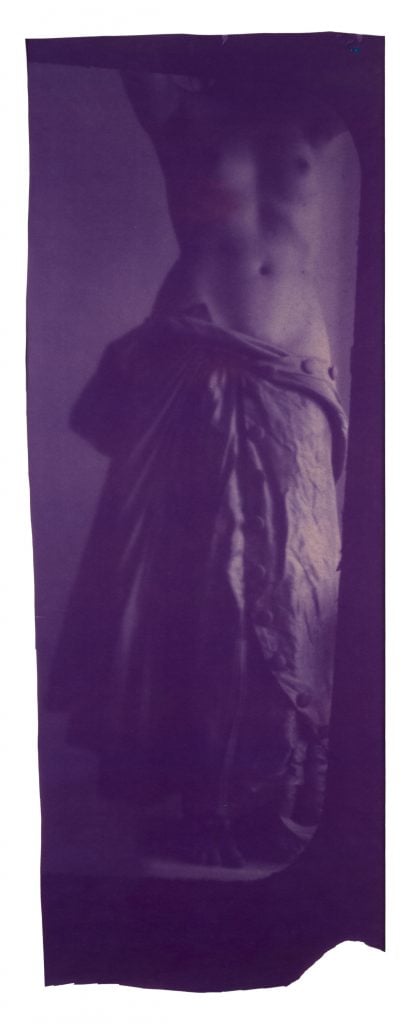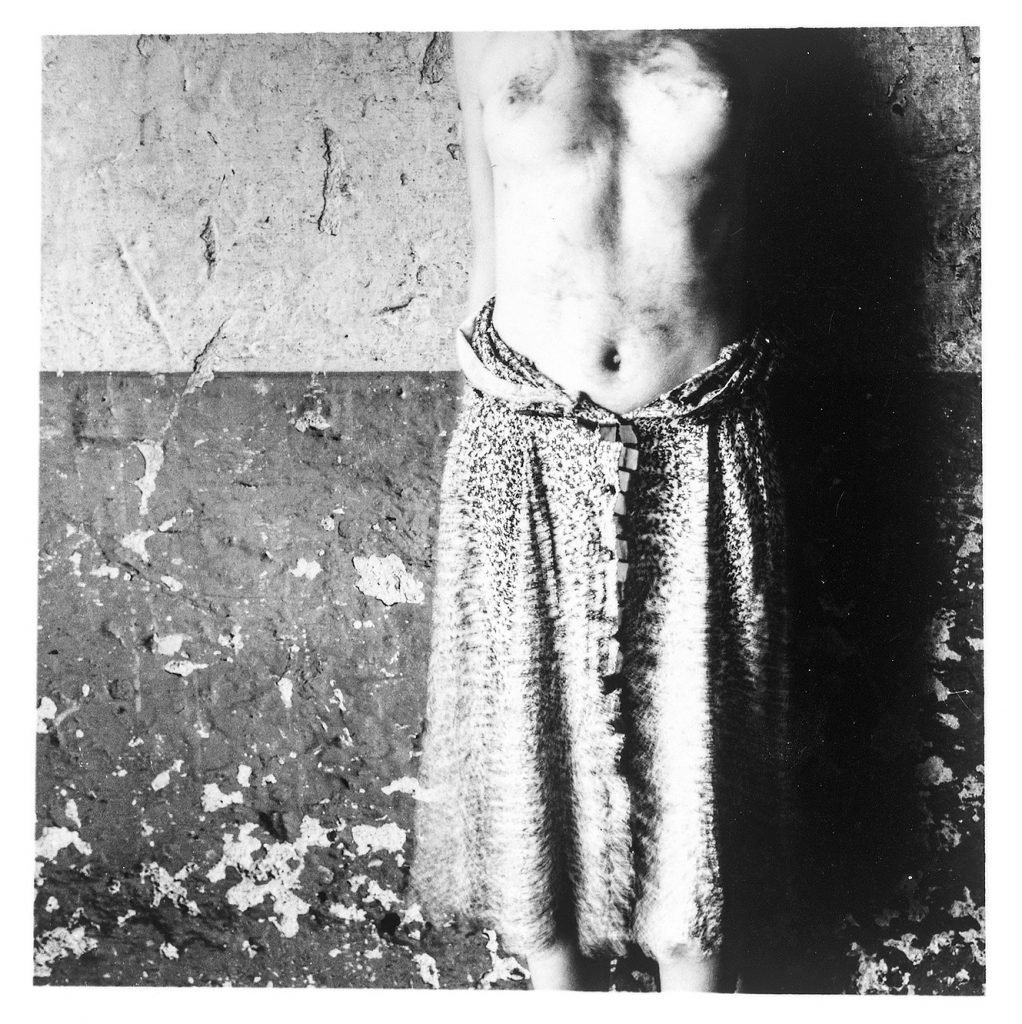Art World
Francesca Woodman Was a Photographic Oracle of an Ancient World
Dozens of photographs by Woodman are on view at Gagosian, New York.

Dozens of photographs by Woodman are on view at Gagosian, New York.

Katie White

A 21-year-old Francesca Woodman stares out of the photograph with a piercing gaze that is startlingly in its intensity. She is standing in her New York City studio nude, her hands clasped in front of her. Her hair, gathered in a loose ponytail, falls down one side of her face. Beside Woodman, taped to the studio wall are works in progress: two larger-than-life photographs of women—friends of Woodman’s—posed as caryatids, classical architectural supports in the shape of women.
In these photographs, the women’s faces are mostly obscured, but their bodies are elegant, sculptural, and draped in fabric. Standing beside the works, Woodman, with her dark looks, appears small but powerful, like an oracle presiding over a classical world of her own imagination.

Francesca Woodman, Untitled (ca. 1979–80). © Woodman Family Foundation / Artists Rights Society (ARS), New York. Courtesy Gagosian and The Woodman Family Foundation.
The photograph, Untitled (ca. 1979–80), is one of 60 works by Woodman now on view at Gagosian in New York, the gallery’s inaugural exhibition of her work (on view through April 27). The exhibition charts photographs made from approximately 1975 through 1980, the year before Woodman’s death by suicide at the age of 22, and the major sites of her creation: in Providence, Rhode Island, while a student at Rhode Island School of Design; in Rome and Ravenna, Italy, while studying abroad in her junior year; and New York where she established a studio and worked until her early death.
The Gagosian exhibition coincides with an exhibition at the National Portrait Gallery in London, which pairs Woodman’s work with English 19th-century photographer Julia Margaret Cameron‘s. These exhibitions are a new high point for Woodman’s work and a career that spanned but a few years. For decades, Woodman’s posthumous legacy was assiduously and passionately advocated by her parents, the artists, Betty and George Woodman. These current exhibitions present the chance to contextualize Woodman’s work in new ways. Gagosian’s exhibition teases out, particularly, Woodman’s fascination with the classical and ancient European world and how photography could be used to transform the body into a sculptural form befitting rites and rituals.
“What you see in this photograph of Woodman posing with the photographs of her friends as caryatids is a jump in scale,” said Katarina Jerinic, collections curator of the Woodman Family Foundation, in conversation. “You get the sense of her as being so small beside them. The caryatids mark a shift from intimate ways of looking, with her gelatin silver prints, to this kind of monumental scale where she is trying to deal with bigger ideas.”

Francesca Woodman, Untitled (1980) from the “Caryatid” series. © Woodman Family Foundation / Artists Rights Society (ARS), New York. Courtesy Gagosian and The Woodman Family Foundation.
The centerpiece of the Gagosian exhibition Blueprint for a Temple (II) (1980) incorporates four caryatids. A monumental, blue-toned photographic collage, the towering work (which measures over 14 feet tall) approximates the facade of a Greek temple. The collage is a playful mix of archaic and intimate references, a high-low counterbalance. Just as each of the caryatids was modeled by Woodman’s friends, the entablature of Temple consists of photographs of bathroom tiles with a Greek key pattern—tiling common to New York City tenement apartments, with which Woodman was familiar. The collage consists primarily of diazotypes, a cheap photo-based process that is best known for use in architectural blueprints. These links to architecture were purposeful—as were the informality and ephemerality of the materials. In this way, Woodman made a temple from her daily life.
Fascinatingly, this major work was unknown until a few years ago when an appraisal of the Woodman estate uncovered a previously unknown cache of works, including Blueprint for a Temple (II). As the “II” suggests, Woodman had completed another temple–Blueprint for a Temple—a collage made in 1980 in the months before her death. This work was ultimately donated to the Metropolitan Museum of Art by Woodman’s parents in 2001.
Blueprint for a Temple II is a bit more open-ended than the Met’s work, with the pediment of the temple shape left open on one side. It is also a bit larger. But the similarities between the two works are more important, hinting at Woodman’s continuous engagement with antiquity, which was growing ever more pronounced in the last months of her life.
In many ways, these classical forms in her final works present new insights into her intimately scaled black-and-white images, for which she is best known. Untitled (ca. 1979–80), mentioned at the beginning of this article, is part of a suite of four “Caryatid/Tulip” photographs that shows the artist in her New York City studio, posing her body amid vases of tulips and her diazotype works.
“These four New York photographs make clear to me her intention of using her body or displaying her body in ways that are sculptural,” explained Jerinic. “In one of these photographs, she is looking into a corner—essentially making her body headless like she is another caryatid. In another, she’s obscuring her arm. Photography is being used to make the body look something other than bodily. There is a lack of super-sharpness in her work that is intentional. Sometimes she is making small motions to create a rounded, marble-like quality with the photograph.”

Francesca Woodman, Untitled (ca. 1977–78). © Woodman Family Foundation / Artists Rights Society (ARS), New York. Courtesy Gagosian and The Woodman Family Foundation.
Italy, in particular, shaped her understanding of the ancient world. Woodman spent part of her childhood in Italy, and, as the child of two artists, had traveled to museums across Europe and to Greece to the Acropolis. During her junior year at Rhode Island School of Design, she studied abroad in Rome, a formative experience. Several photographs in the exhibition show Woodman interacting with classical and sculpture architecture during those years. One photograph—Untitled (ca. 1977–78) shows Woodman, wearing what seems to be the same dress as in her famous “Polka Dot” series, and staring up, her arms flung back, at a colossal sculpture at the Palazzo Cecchini-Lavaggi-Guglielmi in Rome. Another shows the artist interacting in front of the peeling walls of the Basilica of San Francesco in Ravenna.
“Although I spent a good part of my childhood in Italy it was not until 1977–78 when I spent a year in Rome… that I tried to consciously explore through my artwork the counterbalance of the staid layers of Italy’s Art History and the chaos of religion, culture, and politics today,” she wrote in her journal in 1980.
In this light, seemingly unrelated photographs suddenly present classicizing parallels. A series of photographs made while in Providence show Woodman or her models positioned before deteriorating walls, so that visible fragments of the body seem like peeled frescos. In one image, the head of a woman is intentionally cropped out and her dress is rolled down to her waist. Dirt marks the body, an attempt perhaps, to make the bust appear part of the wall itself. In other works, Woodman’s pale body lies on a floor amid towering white plinths, like a sculpture toppled over.

Francesca Woodman, Untitled (ca. 1977–78). © Woodman Family Foundation / Artists Rights Society (ARS), New York. Courtesy Gagosian and The Woodman Family Foundation.
It’s possible to contextualize Woodman’s work with that of her own parents, Betty and George Woodman, whose works don’t necessarily share pronounced aesthetic similarities so much as thematic questions (Betty passed away in 2018; George in 2017). Betty Woodman’s ceramics often pulled from the architecture and ornament of the ancient world. In the 1980s and 90s, Woodman created several installations, including Somewhere Between Denver and Naples and Il Giardino Dipinto, which directly referenced Italian classical architectural spaces. Meanwhile, George Woodman’s photographs often depicted classical sculpture in unexpected ways or at times overlaid the contemporary body and architecture. Of course, it’s interesting to think that Francesca’s works grappled directly with these themes often before her parents (George Woodman’s photography practice only fully commenced in the 1980s).
Considering these interests in their totality, it might be best to say that Francesca Woodman’s photographs hint at the ways our past lives live on within the present, how history becomes an architecture that’s lived within, quite literally by our friends, our families, and our very selves. In a notebook from 1980, Woodman described the process of making a caryatid, “Sitting in bed – the slide projector is humming in the other room – a slide of helen as caryatid – im feeling very very lazy and contented – the cat lounges on a newly washed pile of pink clothes and the room is strewn with fresh tulips – even my fish has fresh flowers from Chinatown.” It’s an intimate window into a photography practice that was moving toward the monumental. Of course, it’s almost impossible to ignore this doubling over into the past. Just as Woodman peered through her camera, her tool of divination, to see into the ancient world in her contemporary moment, we scour her life, and the works she made within it, to try to discern the contours of what might have been.